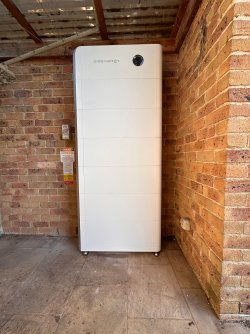Probably best not to export to the grid.Actually it changes from 10yrs unlimited kWh to 37MWh
You are using an out of date browser. It may not display this or other websites correctly.
You should upgrade or use an alternative browser.
You should upgrade or use an alternative browser.
Solar Panel, Power & Battery Discussion
- Thread starter clazman
- Start date
The 1970s kidney-shaped, or the modern octagon?Unfortunately, the shape of our pool provides significant challenges to the installation of a pool blanket.
- Joined
- Oct 13, 2013
- Posts
- 17,142
Export to grid no problem but using it as a VPP changes the warranty from years to MWhProbably best not to export to the grid.
That’s probably what I was trying to recallExport to grid no problem but using it as a VPP changes the warranty from years to MWh
- Joined
- Oct 13, 2013
- Posts
- 17,142
Though if full cycling once a day for 1 year thre throughput is also about 37MWh.
1 cycling per day because Tesla assumes the resident uses solar to charge the battery once a day. But potentially users can charge twice a day - once using solar and once using overnight off peak at 8c/kWh
1 cycling per day because Tesla assumes the resident uses solar to charge the battery once a day. But potentially users can charge twice a day - once using solar and once using overnight off peak at 8c/kWh
- Joined
- Aug 27, 2004
- Posts
- 17,936
- Qantas
- LT Gold
- Virgin
- Red
- Oneworld
- Sapphire
1980s kidney-like shape, I guess. Certainly not modern. Back when proper pools were tiled.The 1970s kidney-shaped, or the modern octagon?
- Joined
- Oct 13, 2013
- Posts
- 17,142
How much was that box @Quickstatus.
- Joined
- Oct 13, 2013
- Posts
- 17,142
$21K after Government carrot. Before government carrot $37K
Includes installation and gateway for blackout function the whole system is modular - can add several of these in series
@cove there are commercial versions
Each module of 8kWh has 23,000 warrantable kWh or 10 years 70% degradation whichever occurs dirst
So 23x6 =138 MWh or 138,000 warrantable kWh
Simplistically allowing for opportunity cost of 6%.
The sunk cost of capital = $28,000
28,000/138,000 =0.203
Cost of energy storage = 20.3c:kWh
But true cost of battery energy = cost of energy to charge battery plus cost of energy storage.
If cost of charging = 5c/kWh from solar then cost of battery energy = 27c/kWh
.....
The batteries charge/discharge at 50% of nominal capacity. 8kWh battery charge/discharge at 4kW. So dimension the inverter with that in mind
Includes installation and gateway for blackout function the whole system is modular - can add several of these in series
@cove there are commercial versions
Each module of 8kWh has 23,000 warrantable kWh or 10 years 70% degradation whichever occurs dirst
So 23x6 =138 MWh or 138,000 warrantable kWh
Simplistically allowing for opportunity cost of 6%.
The sunk cost of capital = $28,000
28,000/138,000 =0.203
Cost of energy storage = 20.3c:kWh
But true cost of battery energy = cost of energy to charge battery plus cost of energy storage.
If cost of charging = 5c/kWh from solar then cost of battery energy = 27c/kWh
.....
The batteries charge/discharge at 50% of nominal capacity. 8kWh battery charge/discharge at 4kW. So dimension the inverter with that in mind
Last edited:
- Joined
- Oct 13, 2013
- Posts
- 17,142
Could have put in a second one easily in series but government carrot not enough to make 2 financially viable.
Last edited:
exceladdict
Senior Member
- Joined
- Mar 26, 2014
- Posts
- 5,122
- Qantas
- Platinum
- Virgin
- Silver
Bumping this thread, I've been working on a simple app to calculate whether a battery is a viable add on for someone with existing solar, using actual usage data rather than the very generous estimates and averages often on solar providers' websites. In other words, if I had a 10kwh battery, how much would my costs have changed in the last year, considering all of the factors raised in this thread (degradation, energy loss, depth of discharge limits, etc).
If anyone in WA is asking the same question and or would like to run their numbers through the system please send me a DM. Would be great to have a few more cases to test, especially for people on different tariffs. Assuming you have a smart meter, you can download your usage in half hourly increments from synergy, and there's no identifying data needed.
Open to building in other states too, but nothing the retail environment and tariff structures are a little more complex so haven't gone there yet.
If anyone in WA is asking the same question and or would like to run their numbers through the system please send me a DM. Would be great to have a few more cases to test, especially for people on different tariffs. Assuming you have a smart meter, you can download your usage in half hourly increments from synergy, and there's no identifying data needed.
Open to building in other states too, but nothing the retail environment and tariff structures are a little more complex so haven't gone there yet.
- Joined
- Mar 26, 2017
- Posts
- 2,549
- Qantas
- LT Gold
- Virgin
- Gold
I'm in the ACT where we have a limited list of providers, so I'd be in if that would help spread your wings for the appBumping this thread, I've been working on a simple app to calculate whether a battery is a viable add on for someone with existing solar, using actual usage data rather than the very generous estimates and averages often on solar providers' websites. In other words, if I had a 10kwh battery, how much would my costs have changed in the last year, considering all of the factors raised in this thread (degradation, energy loss, depth of discharge limits, etc).
If anyone in WA is asking the same question and or would like to run their numbers through the system please send me a DM. Would be great to have a few more cases to test, especially for people on different tariffs. Assuming you have a smart meter, you can download your usage in half hourly increments from synergy, and there's no identifying data needed.
Open to building in other states too, but nothing the retail environment and tariff structures are a little more complex so haven't gone there yet.
daft009
Established Member
- Joined
- Feb 21, 2014
- Posts
- 3,129
- Qantas
- Bronze
- Virgin
- Platinum
WA seems to be quite a closed market?
I feel battery is great if you can tap into wholesale power with Amber electric
I charge my battery with solar and the grid during the day at 6-12c/kWh and then sell at 50c-$20/kWh during the evening peak
Works quite well at my office too as we close at 5pm so a lot can be sold to the grid to improve ROI
I feel battery is great if you can tap into wholesale power with Amber electric
I charge my battery with solar and the grid during the day at 6-12c/kWh and then sell at 50c-$20/kWh during the evening peak
Works quite well at my office too as we close at 5pm so a lot can be sold to the grid to improve ROI
- Joined
- Apr 1, 2009
- Posts
- 19,253
- Qantas
- LT Gold
- Oneworld
- Sapphire
I'm in QLD and have had a battery since beginning of last year, so can give you some data if you like, happy to share all the numbers. My battery is 25.6kWh.Bumping this thread, I've been working on a simple app to calculate whether a battery is a viable add on for someone with existing solar, using actual usage data rather than the very generous estimates and averages often on solar providers' websites. In other words, if I had a 10kwh battery, how much would my costs have changed in the last year, considering all of the factors raised in this thread (degradation, energy loss, depth of discharge limits, etc).
If anyone in WA is asking the same question and or would like to run their numbers through the system please send me a DM. Would be great to have a few more cases to test, especially for people on different tariffs. Assuming you have a smart meter, you can download your usage in half hourly increments from synergy, and there's no identifying data needed.
Open to building in other states too, but nothing the retail environment and tariff structures are a little more complex so haven't gone there yet.
Wish I could go solely with Amber - my battery isn't technically supported by them, so I have to use another company in between and it's not as flexible from what I understand as the full offering, so I've been reluctant to bite the bullet. I do fairly well with my solar/battery combo though. Switched to TOU to escape pesky demand charges and tend to actually draw about 15kWh/month - my biggest cost being the supply charge. Then it's just a case of re-filling the battery each morning and selling as much as I can back to the grid to offset the supply charge.I feel battery is great if you can tap into wholesale power with Amber electric
I charge my battery with solar and the grid during the day at 6-12c/kWh and then sell at 50c-$20/kWh during the evening peak
Tends to result in about $5 credit a month, but the overall saving (solar/battery consumed on site + energy imported - solar sold to grid) is about $4500/year as my house tends to consume a lot of power. But I guess those values change based on what the power company charges for power and pays for power.
daft009
Established Member
- Joined
- Feb 21, 2014
- Posts
- 3,129
- Qantas
- Bronze
- Virgin
- Platinum
Due to space and clearances needed my home battery is 16kWh, really wanted 25kWh but too tall as I had a window above. Doesn't give me much spare capacity to sell too much.
Office/factory unit is 25kWh but we also use more during the day so trying to upgrade that now to 40kWh and take advantage of the federal rebate.
Did NSW state rebates first time around and the instant asset write off upto $20k so a no brainer for the office
Amber is not perfect. I still haven't had any actual bills, just crossed 3 months now.
For home they seem to count my solar generation twice which they still haven't fixed, been an issue 2wks+. So if it's generating 1kW, Amber is showing it as 2kW
Office/factory unit is 25kWh but we also use more during the day so trying to upgrade that now to 40kWh and take advantage of the federal rebate.
Did NSW state rebates first time around and the instant asset write off upto $20k so a no brainer for the office
Amber is not perfect. I still haven't had any actual bills, just crossed 3 months now.
For home they seem to count my solar generation twice which they still haven't fixed, been an issue 2wks+. So if it's generating 1kW, Amber is showing it as 2kW
- Joined
- Apr 1, 2009
- Posts
- 19,253
- Qantas
- LT Gold
- Oneworld
- Sapphire
I have a battery that can run in series over several stacks, so I have two stacks due to height issues, and am talking with my installer about adding a third stack now the federal rebate is around to potentially get to about 38.4 kWh total.Due to space and clearances needed my home battery is 16kWh, really wanted 25kWh but too tall as I had a window above. Doesn't give me much spare capacity to sell too much.
I have an EV and work in the office Monday/Wednesday/Friday with limited charge infrastructure nearby where I live or work, so the ability to properly top up my car and also keep my house power cheap is what is driving me to think I just need a little bit more stored. Otherwise, I tend to charge mid-week at a shopping centre on the way home, which is still cheaper than a gas car, but not as cheap as "free".
exceladdict
Senior Member
- Joined
- Mar 26, 2014
- Posts
- 5,122
- Qantas
- Platinum
- Virgin
- Silver
Yes, synergy (govt owned) is the retailer for households. Makes comparing choices a little easier!WA seems to be quite a closed market?
I feel battery is great if you can tap into wholesale power with Amber electric
The opportunity for energy trading sounds exciting, especially if significantly exceeding the effective cost-per-kwh dividing the cost of a battery by the number of warranted KWH it can discharge. No chance we'll be doing that on the maximum 10c/kwh peak-period FIT here in WA
- Joined
- Oct 13, 2013
- Posts
- 17,142
Sigenergy 3 phase 48kWh/25kW (battery capacity/inverter capacity)
In operation for 31days
Total 1.75MWh (1700kWh) have been sent through the battery
Cost of electricity going into battery:
10% at a cost of 8c/kWh (overnight tariff)
2% at a cost of 6 c/kWh (foregone solar FiT plus capital cost of solar + cost of capital , amortised over 20years)
88% at a cost of 0c/kWh (free tariff)
Cost of storing electricity:
=Capital cost of battery+ cost of capital amortised over warranty period and expressed as cents per warranted kWh. = 21c/kWh
Cost of electricity coming out of battery:
= cost of electricity to charge battery plus cost of storing electricity. So add 21c to the cost of electricity. Smaller capacity Sigenergy battery cost more on a c/kWh basis
Have a couple of acquaintances who have negative Amber experience so have left that provider.
In operation for 31days
Total 1.75MWh (1700kWh) have been sent through the battery
Cost of electricity going into battery:
10% at a cost of 8c/kWh (overnight tariff)
2% at a cost of 6 c/kWh (foregone solar FiT plus capital cost of solar + cost of capital , amortised over 20years)
88% at a cost of 0c/kWh (free tariff)
Cost of storing electricity:
=Capital cost of battery+ cost of capital amortised over warranty period and expressed as cents per warranted kWh. = 21c/kWh
Cost of electricity coming out of battery:
= cost of electricity to charge battery plus cost of storing electricity. So add 21c to the cost of electricity. Smaller capacity Sigenergy battery cost more on a c/kWh basis
Have a couple of acquaintances who have negative Amber experience so have left that provider.
Last edited:
Read our AFF credit card guides and start earning more points now.
AFF Supporters can remove this and all advertisements
Become an AFF member!
Join Australian Frequent Flyer (AFF) for free and unlock insider tips, exclusive deals, and global meetups with 65,000+ frequent flyers.AFF members can also access our Frequent Flyer Training courses, and upgrade to Fast-track your way to expert traveller status and unlock even more exclusive discounts!

AFF forum abbreviations
Wondering about Y, J or any of the other abbreviations used on our forum?Check out our guide to common AFF acronyms & abbreviations.
Currently Active Users
- ksthommo
- jakob
- Mr H
- Zoneboarder
- http_x92
- Andy72
- moa999
- wenglock.mok
- clifford
- Carasmw
- RooFlyer
- mms498
- kpc
- jkbaus
- Airbumps
- AndrewCowley
- WineNewbie
- ryanmc
- Mqrko
- Flyfrequently
- anat0l
- Dmac59
- bpc
- Harrison_133
- XavierP
- Virgin Bart
- jase05
- larry40
- Rangalad
- SydneySwan
- Ubern
- Balus1
- Gudetama
- aus_flyer
- QFFHntrGthr
- Arkana
- Austman
- Daver6
- sudoer
- Kwong
- SOPOOR
Total: 687 (members: 48, guests: 639)














